The MacBook Pro Review (13 & 15-inch): 2011 Brings Sandy Bridge
by Anand Lal Shimpi, Brian Klug & Vivek Gowri on March 10, 2011 4:17 PM EST- Posted in
- Laptops
- Mac
- Apple
- Intel
- MacBook Pro
- Sandy Bridge
Performance
For our performance comparison I actually dusted off some of our 2008 8-core Mac Pro data just to show you exactly how close to a high end desktop the new quad-core MacBook Pro has come. Note that we only have comparative data for a few benchmarks so you may see the Mac Pro disappear from a few charts.
Keep in mind that the Mac Pro numbers are taken with a 3.5" hard drive (vs. the 2.5" HDD in the MBP). The big difference however is microprocessor architecture. In 2008 the Mac Pro was still running Core 2 based CPUs, while Sandy Bridge is two tocks away. What the new MBPs lack in TDP headroom and core count, they can make up for in clock speed. The result is that for the first time since I've been reviewing Apple hardware we have portable Macs that can truly hang with their desktop brethren (with some caveats of course). In order to truly bridge the mobile/desktop gap you definitely need an SSD; a 2.5" hard drive just isn't going to cut it. The Mac Pro still has a pure core count advantage. The reason I feel like the mobile/desktop gap has narrowed is because while I feel that there is a general performance benefit when going from 2 to 4 cores, it's far more difficult to find applications or usage models that take advantage of 8 or more cores.
The gap will grow once more as the iMac and Mac Pro get updated with Sandy Bridge hardware later this year, but I suspect that for even desktop users a 15-inch MacBook Pro paired with an external display may be near perfect. I believe this is a big reason for pushing Thunderbolt in this generation. While the standard may not really take off until next year, the new 15-inch MBP is definitely built for desktop replacement usage models and for that to work without sacrifice you need high speed external storage.
Adobe Photoshop CS4 Performance
The Retouch Artists Speed Test we use for our CPU testing under Windows also works under OS X. We're running the exact same benchmark here, basically performing a bunch of image manipulations and filters and timing the entire process.
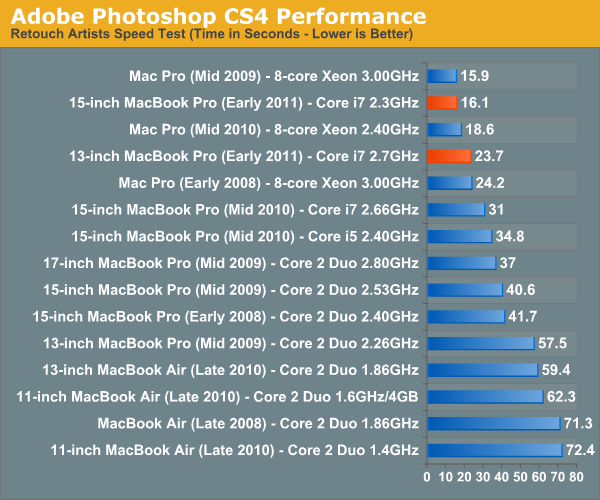
Photoshop performance is just amazing on the new systems. The high end 15-inch MacBook Pro is actually faster than last year's 8-core Mac Pro. Of course this is because Photoshop doesn't scale perfectly with core count but it just shows you just how powerful these new quad-core CPUs are.
Owners of last year's 13-inch MBP will notice that the new high end 13-inch can run through our CS4 test in roughly half the time. The performance improvement is of course exaggerated because Apple kept the 13 on Core 2 for longer than it should have, but what's important is that the new 13 is really fast.
If you do a lot of Photoshop work, the Sandy Bridge upgrade will be worth it.
Aperture 2 RAW Import
For my Aperture test I simply timed how long it took to import 203 12MP RAW images into the library.
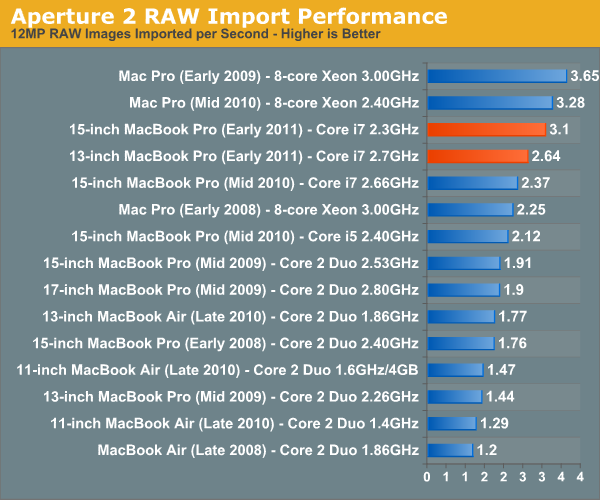
Aperture performance is similarly class leading. Here the 2010 Mac Pro actually outperforms the high end 15 by around 6% but the fact that we can even mention the two in the same sentence is huge.
The new 13 is still really quick, itself faster than a Mac Pro from as recently as 2008 in this test.
Cinebench R10 & 11.5
I’m a fan of the Cinebench tests because they lets me show off both single and multithreaded performance in the same workload. First, the single threaded performance:
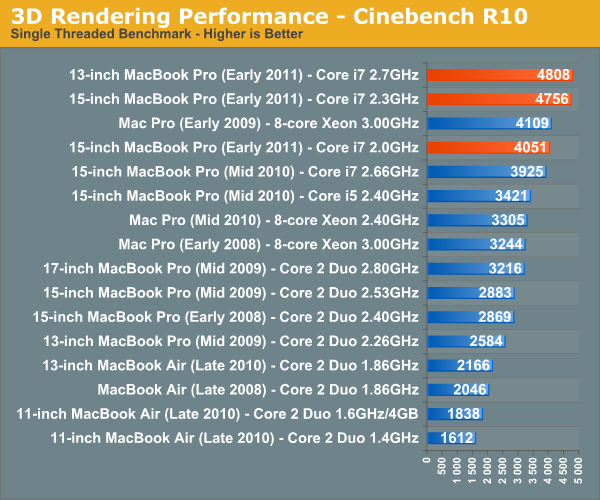
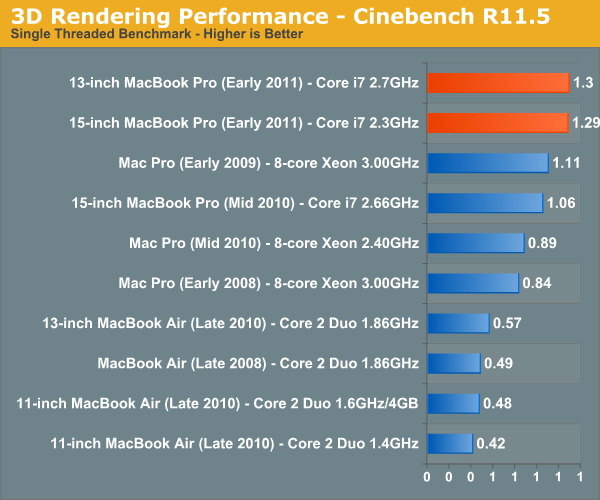
Single threaded performance is really where these systems shine and it's what makes them feel so fast in normal usage. Even the base 15-inch MacBook Pro has better single threaded performance than last year's high end model.
You'll notice that the 13-inch 2.7GHz MBP has a bit of an edge compared to the 15-inch 2.3GHz system here. Although both chips can technically turbo up to 3.4GHz with only one core active, Apple seems to limit the 13-inch dual-core less. As a result it will sometimes have higher single threaded performance than the 15. I noticed this in actual usage as well. The advantage is very subtle and really only visible if you do a side to side comparison however.
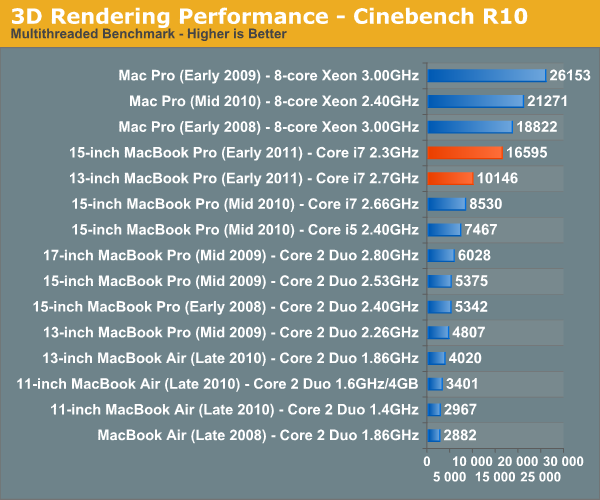
Multithreaded performance is obviously a huge boon on the 15-inch MacBook Pro. With four cores and eight threads the new 15-inch MBP behaves a lot more like a desktop than a notebook. Multithreaded performance is also one area where the high end Mac Pros do a lot better as they have twice the cores of even the 15-inch MBP.
Quicktime H.264 Video Encoding
Our final benchmark is more consumer focused. Here I'm taking an XviD and converting it to an iPhone-supported H.264 format.
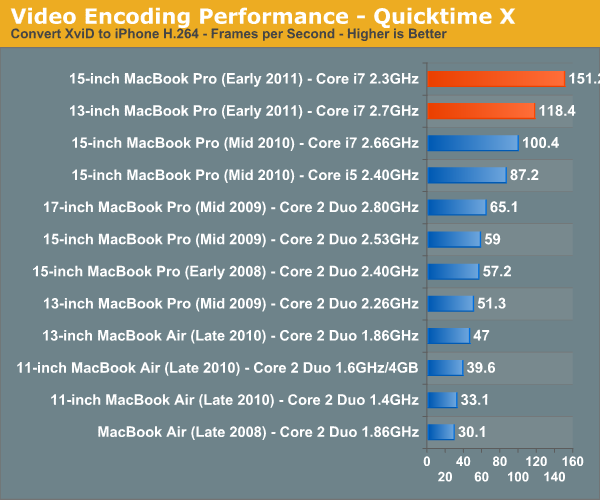
Despite missing Quick Sync support, the 2011 MacBook Pros do very well in our video transcoding tests. If Apple does get around to enabling Quick Sync you can expect the performance advantage to grow even more.










198 Comments
View All Comments
zappb - Saturday, March 12, 2011 - link
Give me a mac book pro with windows 7 as a base install, and id be all over it.Mac OS sucks ass, don't know how anyone can make any money using it. Windows or ill stick to lenovo, would rather send my hard earned dollars to apple but as it stands, not a chance.
bymi - Saturday, March 12, 2011 - link
Hi,thanks for the great review of the new MacBooks!
I googled a lot, but was not able to find a working copy of the MSR Tools used in his article.
Sorry if this hat been discussed before, but i didn't find anything using the search funtionality here.
So where can i get these MSR Tools?
Thank you everybody for a link.
Best
bymi
Ryan Smith - Sunday, March 13, 2011 - link
http://www.insanelymac.com/forum/index.php?showtop...Note that it only works with Snow Leopard booted up in to 32bit mode, as the driver needed to read the MSRs is 32bit.
philipus - Saturday, March 12, 2011 - link
Does anyone know the approximate battery life when using Photoshop (I have CS5) with the dGPU enabled vs disabled?What is the approximate performance drop in Photoshop when not using the dGPU?
These are my main questions before deciding to get the 15" MBP.
Thanks for any insight.
/p
http://philipus.com
fcarnival - Sunday, March 13, 2011 - link
Hello Anandtech, thanks for the Apple's revenue breakdown. Could you also post the profit breakdown of Apple's products? I would like to know which device brings the most profit to Apple. Thanks!macfanpro - Monday, March 14, 2011 - link
I am very curious about this as well - with the tablet market supposedly tripling this year, I want to know what the ramifications are for earnings.Apple has a very nice page with related data (http://www.apple.com/investor/), but alas, I don't think they provide earnings breakdown by product (it's not in their detailed 70+ page annual report)...
amanrai - Monday, March 14, 2011 - link
could you confirm, definitively, whether or not the thunderbolt port will be able to support a discrete pci e based graphics card with or without a HDMI combination?thank you for all of your reviews. they are incredibly detailed and very helpful.
macfanpro - Monday, March 14, 2011 - link
Thanks so much for such an insightful review! I'm trying to rationalize buying a MBP, and I have two questions:Question about power draw) The MBP comes with a 85W adapter, but its maximum power draw is 93.2W. Could this lead to throttling/maximum performance not being achieved even when one is on the adapter?
Question about turbo boost) Some people have reported the turbo boost (for the i7 MBP 13) not working in Boot Camp. (Link: http://www.pcpro.co.uk/blogs/2011/03/10/apple-macb... Do you have any more news on this front?
anaboo - Monday, March 14, 2011 - link
Strong article - appreciate the in depth of benchmarks and insight.I'm hoping you guys can run the same set of in-depth Windows gaming benchmarks on the 15-inch MBP (particularly for the radeon gfx card). Curious to whether there is sub-optimal performance against a similar set of comparables (2010 MBPs, the Mac versions of these games, etc.).
Thanks!
davidglennbailey - Wednesday, March 16, 2011 - link
Best article on the internet on the new Macbook Pros. I'm ordering a 17" Macbook Pro on Friday. Here are my issues.1. Just take the cheap SATA hard drive now and upgrade to a fast SSD in the future when the prices fall a little farther? I will probably void a warranty? How difficult is the process to change one of those out and my chances of screwing something up? How do they even connect inside the machine and how reliable is it?
2. I can understand increased functionality spread out over the life of a product, but even at 3+ years is the .1ghz for 250$ ever worth it? Maybe for the increased cache or any other features?
3. Upgrading the memory was a breeze last time and shouldn't be an issue. Would there be any point or would it be even possible to go above 1333mhz or 8 gigs?
Just to add my 2 cents into the debate. I've had this Macbook Pro for about 5 years. I've put it through hell and back. Sometimes, you just wind up getting what you pay for. Great time to buy if you've been waiting for the quad cores for a while.